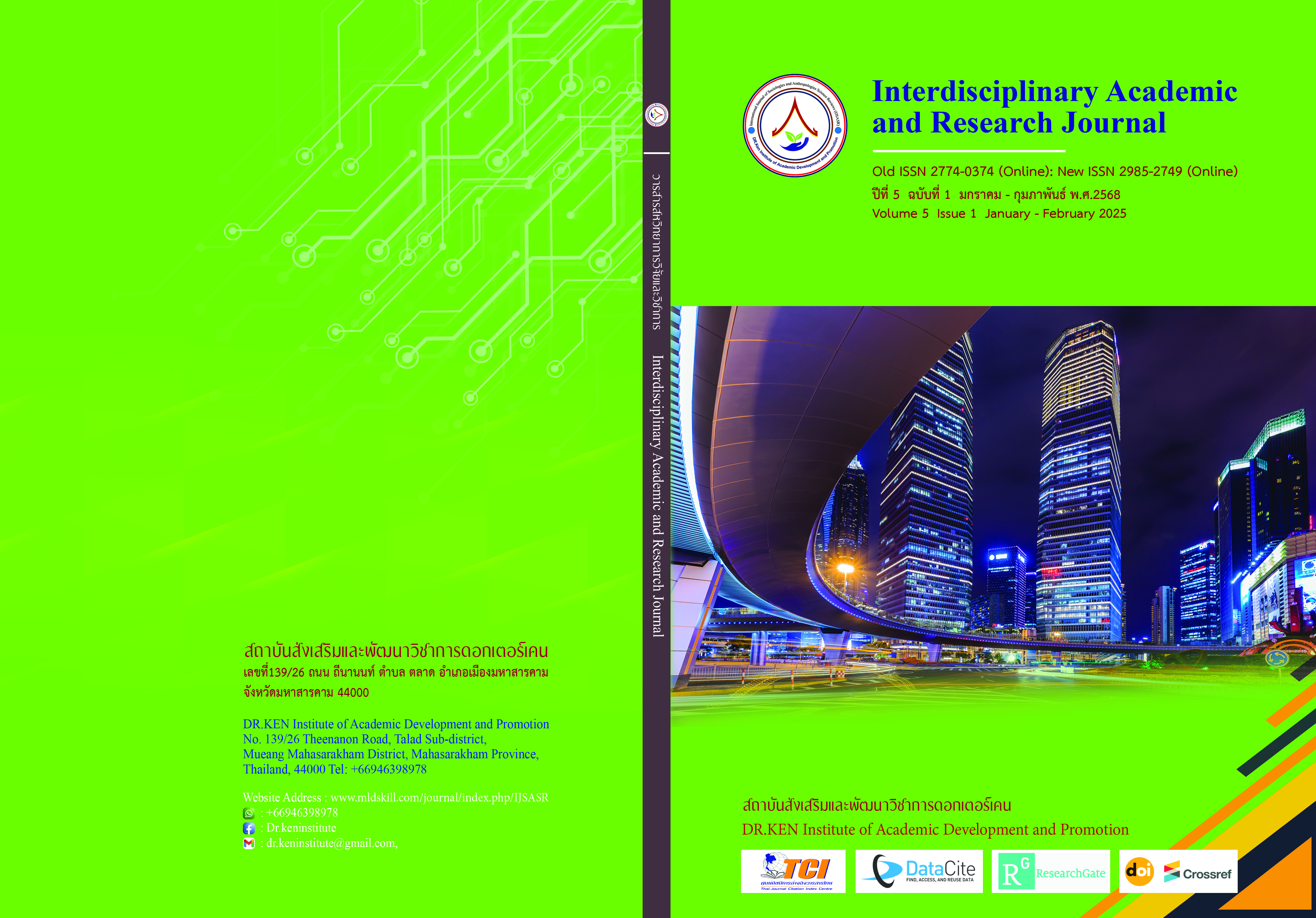The Development of Tourism Management Models in Yaowarat for Enhancing Efficient and Sustainable Tourist Carrying Capacity
DOI:
https://doi.org/10.60027/iarj.2025.280231Keywords:
Overtourism, Tourist carrying capacity, Sustainable tourism, Tourism imageAbstract
Background and Aims: The Yaowarat district in Bangkok is facing problems of overtourism, resulting in traffic issues, environmental concerns, and risks of losing cultural identity. The objectives of this research are: 1) To study tourism components, tourist carrying capacity, perception of image, and efficiency of tourism area management in Yaowarat. 2) To examine the relationships between tourism components, tourist carrying capacity, image perception, and tourism area management efficiency in Yaowarat. 3) To investigate the influences among tourism components, tourist carrying capacity, perception of image, and the efficiency of tourism area management in Yaowarat, and 4) To develop an efficient tourism management model for Yaowarat that can sustainably accommodate tourists.
Methodology: This study employs a mixed-method approach, combining quantitative and qualitative research. The quantitative sample consists of 600 Thai and foreign tourists, selected through multi-stage sampling. Data was collected using a questionnaire with an IOC of 0.89 and a reliability of 0.92. Descriptive statistics, correlation analysis, and multiple regression analysis were used. The qualitative research involved in-depth interviews with 15 key informants, including government officials, entrepreneurs, and community representatives. Content analysis and triangulation were used to analyze and verify the data.
Results: The findings show that 1) tourism components are at a high level (mean 3.80); 2) tourists perceive Yaowarat's image at a high level (mean 3.76); 3) tourism components have a strong positive correlation with management efficiency (r = 0.68-0.75); 4) an efficient and sustainable tourism management model for Yaowarat is proposed, considering economic, social, and environmental sustainability to enhance community quality of life and conserve tourism resources in the long term.
Conclusion: The development of an efficient and sustainable tourism management model for Yaowarat comprises six main aspects: 1) developing tourism attractions while preserving culture and promoting local identity; 2) improving facilities; 3) developing diverse accommodations consistent with the local context; 4) enhancing accessibility and traffic management; 5) upgrading tourist services; and 6) promoting participatory activities. This model emphasizes economic, social, and environmental sustainability to enhance community quality of life and conserve tourism resources in the long term.
References
กรรณิกา สงวนสินธุกุล และวิญญู อาจรักษา. (2560). แนวทางการพัฒนาการท่องเที่ยวเชิงวัฒนธรรมในย่านเยาวราช กรุงเทพมหานคร. วารสารวิชาการการท่องเที่ยวไทยนานาชาติ, 13(1), 59-76.
กรุงเทพมหานคร. (2562). ประวัติเยาวราช. กรุงเทพฯ: สำนักวัฒนธรรม กีฬา และการท่องเที่ยว.
ขวัญใจ ประเสริฐศรี. (2565). ภาพลักษณ์แหล่งท่องเที่ยวและพฤติกรรมนักท่องเที่ยว. วารสารวิชาการการท่องเที่ยวไทยนานาชาติ, 18(2), 1-15.
ฐิติพงศ์ ศรีพิทักษ์. (2566). แนวทางการจัดการภาวะนักท่องเที่ยวล้นเมืองในเยาวราช: กรณีศึกษาการมีส่วนร่วมของชุมชน. วารสารการจัดการการท่องเที่ยว, 5(1), 112-130.
นิธินันท์ ประเสริฐทรัพย์, มณีศรี สุรศักดิ์ และชัยยศ บุญช่วย. (2565). การจัดการภาวะนักท่องเที่ยวล้นเมืองในเยาวราช: มุมมองของชุมชนท้องถิ่น. วารสารการจัดการสิ่งแวดล้อม, 18(2), 45-62.
ศิริพร ทิพย์เกษร. (2566). การจัดการการท่องเที่ยวเชิงวัฒนธรรมในชุมชนเยาวราช: มุมมองของชุมชนท้องถิ่น. วารสารการท่องเที่ยวไทยนานาชาติ, 19(1), 78-95.
สุรศักดิ์ มณีศรี. (2564). ผลกระทบของภาวะนักท่องเที่ยวล้นเมืองในเยาวราช กรุงเทพมหานคร. วารสารวิชาการการท่องเที่ยวไทยนานาชาติ, 17(2), 1-22.
Acharya, A. S., Prakash, A., Saxena, P., & Nigam, A. (2013). Sampling: Why and how of it? Indian Journal of Medical Specialties, 4(2), 330-333.
Beauchamp, T. L., & Childress, J. F. (2001). Principles of biomedical ethics. (5th ed.). Oxford University Press.
Bramwell, B., & Lane, B. (2011). Critical research on the governance of tourism and sustainability. Journal of Sustainable Tourism, 19(5), 411-421.
Buhalis, D. (2000). Marketing the competitive destination of the future. Tourism Management, 21(1), 97-116.
Butler, R. W. (1980). The concept of a tourist area cycle of evolution: Implications for management of resources. Canadian Geographer, 24(1), 5-12.
Butler, R. W. (1999). Sustainable tourism: A state‐of‐the‐art review. Tourism Geographies, 1(1), 7-25.
Chen, S., & Kumar, V. (2021). Exploring the role of food tourism in destination branding: A study of Yaowarat, Bangkok's Chinatown. Journal of Tourism Studies, 33(2), 145-162.
Chen, Y., & Wang, L. (2022). Destination image perception and tourist loyalty: A meta-analysis. Tourism Management, 88, 104400.
Cohen, E. (1972). Toward a sociology of international tourism. Social Research, 39(1), 164-182.
Creswell, J. W. (2013). Qualitative inquiry and research design: Choosing among five approaches (3rd ed.). Sage.
Creswell, J. W., & Plano Clark, V. L. (2018). Designing and conducting mixed methods research (3rd ed.). SAGE Publications.
Doe, J. (2023). Understanding destination image: A comprehensive review. Journal of Travel Research, 62(4), 789-801.
Dredge, D. (2017). "Overtourism" Old wine in new bottles? Tourism Recreation Research, 42(4), 391-396.
Dwyer, L., & Kim, C. (2003). Destination competitiveness: Determinants and indicators. Current Issues in Tourism, 6(5), 369-414.
Echtner, C. M., & Ritchie, J. R. B. (2003). The meaning and measurement of destination image. Journal of Tourism Studies, 14(1), 37-48.
Faulkner, B., & Tideswell, C. (1997). A framework for monitoring community impacts of tourism. Journal of Sustainable Tourism, 5(1), 3-28.
Goodwin, H. (2017). The challenge of overtourism. Responsible Tourism Partnership Working Paper 4.
Guest, G., Bunce, A., & Johnson, L. (2006). How many interviews are enough? An experiment with data saturation and variability. Field Methods, 18(1), 59-82.
Hall, C. M. (2019). Constructing sustainable tourism development: The 2030 agenda and the managerial ecology of sustainable tourism. Journal of Sustainable Tourism, 27(7), 1044-1060.
Hall, C. M. (2008). Tourism planning: Policies, processes and relationships. Pearson Education.
Koens, K., Postma, A., & Papp, B. (2018). Is overtourism overused? Understanding the impact of tourism in a city context. Sustainability, 10(12), 4384.
Kostrowicki, J. (1970). Geographical typology of agriculture. Principles and methods. An invitation to discussion. Geographia Polonica, 19, 249-269.
Kowalski, R. M., & Limber, S. P. (2013). Psychological, physical, and academic correlates of cyberbullying and traditional bullying. Journal of Adolescent Health, 53(1), S13-S20.
Leiper, N. (1990). Tourist attraction systems. Annals of Tourism Research, 17(3), 367-384.
Likert, R. (1932). A technique for the measurement of attitudes. Archives of Psychology, 22(140), 1-55.
Milano, C., Cheer, J. M., & Novelli, M. (2019). Overtourism: Excesses, discontents and measures in travel and tourism. CABI.
Miles, M. B., & Huberman, A. M. (1994). Qualitative data analysis: An expanded sourcebook (2nd ed.). Sage.
Nunnally, J. C., & Bernstein, I. H. (1994). Psychometric theory. (3rd ed.). McGraw-Hill.
O'Reilly, A. M. (1986). Tourism carrying capacity: Concept and issues. Tourism Management, 7(4), 254-258.
Pearce, P. L. (1988). The Ulysses Factor: Evaluating Visitors in Tourist Settings. Springer-Verlag.
Pongpanich, T., & Intarat, N. (2020). Managing overtourism in Yaowarat: A case study of Bangkok's Chinatown. Journal of Thai Hospitality and Tourism, 15(1), 1-20
Presenza, A., Sheehan, L., & Ritchie, J. B. (2005). Towards a model of the roles and activities of destination management organizations. Journal of Hospitality, Tourism and Leisure Science, 3(1), 1-16.
Richards, G., & Hall, D. (2000). Tourism and sustainable community development. Routledge
Rovinelli, R. J., & Hambleton, R. K. (1977). On the use of content specialists in the assessment of criterion-referenced test item validity. Dutch Journal of Educational Research, 2, 49-60.
Smith, A. (2023). The role of communication in shaping destination image. Tourism Management Perspectives, 45, 100959.
Song, H., & Li, G. (2022). Tourism overload in heritage sites: A case study of Xi'an, China. Journal of Sustainable Tourism, 30(2-3), 522-541.
United Nations Environment Programme (UNEP) and World Tourism Organization (UNWTO). (2005). Making Tourism More Sustainable - A Guide for Policy Makers. UNEP and UNWTO.
United Nations World Tourism Organization (UNWTO). (2019). Overtourism? Understanding and managing urban tourism growth beyond perceptions. Madrid: UNWTO.
United Nations World Tourism Organization (UNWTO). (2004). Indicators of sustainable development for tourism destinations: A guidebook. Madrid: UNWTO.
Wall, G. (1999). Sustainable tourism – unsustainable development. In J. J. Pigram & S. Wahab (Eds.), Tourism, Development and Growth: The Challenge of Sustainability (pp. 33-49). Routledge.
World Tourism Organization. (2019). Overtourism? Understanding and Managing Urban Tourism Growth beyond Perceptions. Madrid: UNWTO.
Zúñiga, F. (2018). The history of Bangkok's Chinatown. In Urban Development in Asia and the Pacific (pp. 145-160). Routledge.
Downloads
Published
How to Cite
Issue
Section
License
Copyright (c) 2025 Interdisciplinary Academic and Research Journal

This work is licensed under a Creative Commons Attribution-NonCommercial-NoDerivatives 4.0 International License.
Copyright on any article in the Interdisciplinary Academic and Research Journal is retained by the author(s) under the under the Creative Commons Attribution-NonCommercial-NoDerivatives 4.0 International License. Permission to use text, content, images, etc. of publication. Any user to read, download, copy, distribute, print, search, or link to the full texts of articles, crawl them for indexing, pass them as data to software, or use them for any other lawful purpose. But do not use it for commercial use or with the intent to benefit any business.
















.png)


